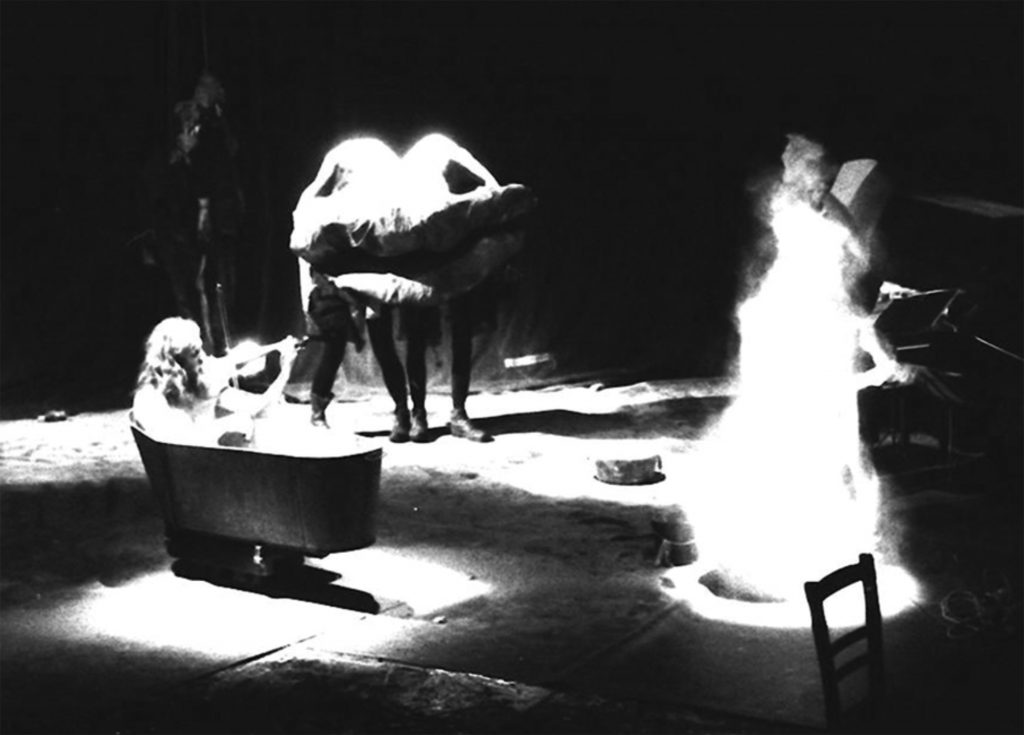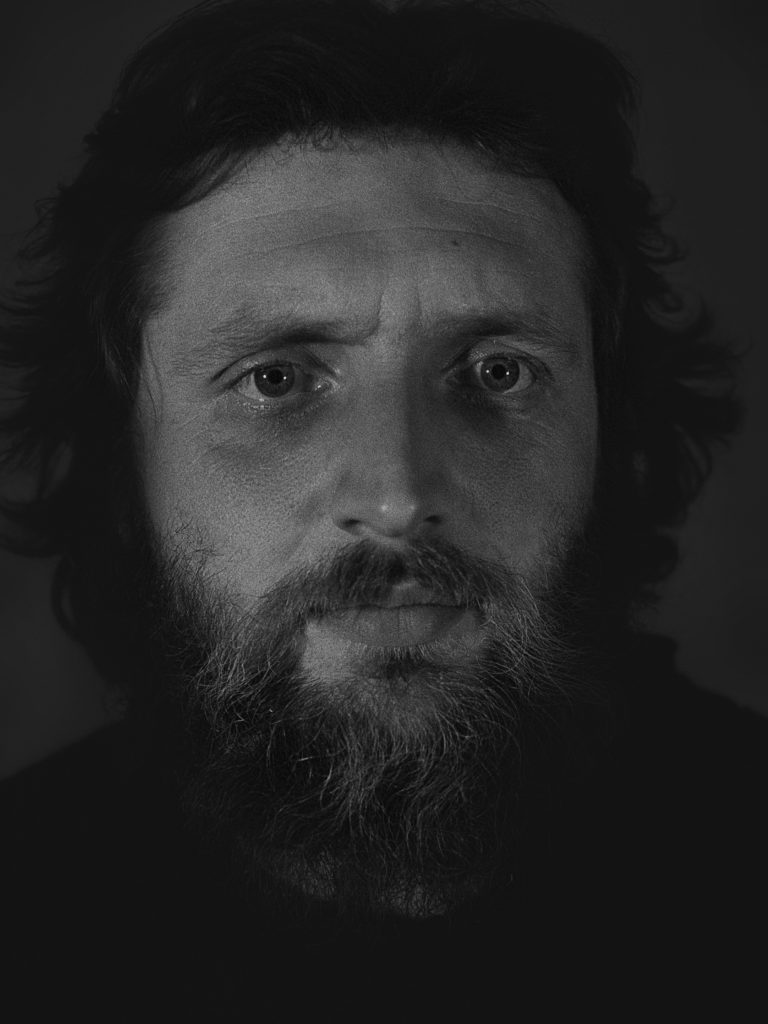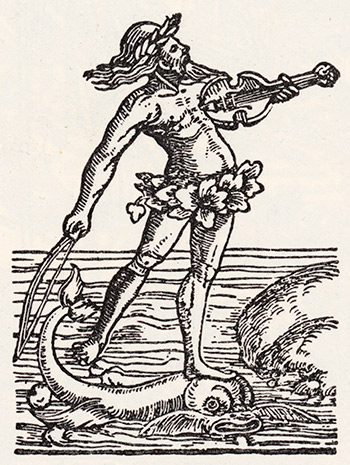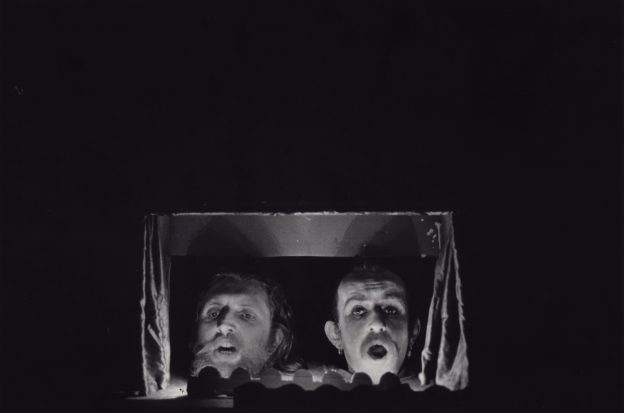David Humpage (1946–2020) was a composer and musician, and a founder member of the legendary IOU theatre and outdoor arts company. David was one of a small group of artists who co-devised and toured together for over twenty years, from 1977 to 1999. His music was an integral part of each show – the visual and musical elements together establishing IOU’s distinctive style. Here, three of his colleagues pay tribute: David Wheeler, one of the company’s founder members and current artistic director; Lou Glandfield, musician/composer and a founder member of IOU; and Edward Taylor, longtime admirer and sometime company performer.
David Wheeler, founder member and current artistic director of IOU, writes:
The balance of temperaments, skills and talents in the early years of IOU was fortuitous. We were all very different – extremely different – and the way we all came together, found each other, seemed very natural. For the first ten years, the artists operated with a collective ethos, enabled by remarkable administrators, but from its inception, IOU was formed as a limited company with charitable status and all the artists and staff were board members. Not something that would be possible today.
I think all of us from those early days would say that we formed our own personal styles through our contact with each other, and through those influences formed a recognisable IOU aesthetic. None of us would be doing what we are doing now if it hadn’t been for that period; neither would IOU.
David Humpage in that mix was very influential. He created overarching musical structures and though we might have jibed him about them at the time, we were all very happy and grateful to make full use of them.
The music, performance and visual ideas would evolve together, often on location in the few days before a production. Ideas were bounced back and forth between the musicians and artists; sometimes the artists saying that a section of music was too short or too long for a performance idea and sometimes the musicians would be saying the music structure needed to keep its shape. Adjustments were made on both sides and I remember this being a remarkably amicable process, although I am sure there were exceptions. However, by the time we were about to go on stage for the first time, the performers knew that the music would work and hold it all together. This trust was important as often we would only have time to talk through ideas before performing them live to an audience – full rehearsals were sometimes a dispensable luxury. The music, and visible musicians, were in the real and conceptual foreground for good reason.
One aspect of IOU’s work is that words are just another important element in the work, they aren’t necessarily the starting point or the story. The music and the musical structure often took this role. This allowed those of us who made the visual content able to weave together contrasting scenes, their connections elusive, dreamlike and enigmatic. It is an important ingredient that audience members bring their own imagination and interpretation to the work.
Ten years into IOU’s now forty-five years of life, the collective ethos had begun to evolve and the founder members no longer wanted to be in every show. A greater number of freelance artists and musicians were working on productions and the whole alternative scene was changing. David had an enormous amount of music to create in his life and stayed with IOU for a further ten years, but eventually the company was no longer the place where he felt he could make it.
David is a key character in the development of IOU and the influence this had on the sector. For me he was also a dear friend for twenty years, and I will continue to miss him.

Lou Glandfield, musician and founder member of IOU, writes:
David played with IOU for the first time in Rotterdam in 1977. Although we were in several respects polar opposites, my connection with David was immediate. When we met he was fresh from the Darmstadt/Stockhausen end of things and I was coming from folk and blues clubs. His initial reaction to the music which I was already writing and playing with the cellist Colin Wood was one of sheer disbelief. ‘I thought it was just Toytown music,’ he later told me.
IOU’s music in the mid-seventies was unapologetically unfashionable and, looked at in the context of the time, radically conservative. As such it was roundly deplored by some of our avant garde peers. We enjoyed playing to their opprobrium, flaunting our college scarves and music cases. Yet, almost immediately, David got it. Bringing a lively complexity to the mix, he jumped in with Tales of Fire – a setting of one of his own poems as a sprightly homage to De Machaut for Wet Maps, Dry Seas at Oval House.
IOU’s music quickly took on a distinct identity – an austere and often mournful quality oddly reminiscent of Scandinavian village bands – in which the default line-up was Colin on cello, me on harmonium and vocal, and David on viola or violin. Additionally Colin played bass trumpet, I played French horn and guitar, David played recorders, and we all played percussion. This set the scene for the next 20 years which saw a prolonged exhumation and re-examination of historic styles.
Our settings of Snoo Wilson’s poems (which he claimed were written in the Vendée dialect but which I maintain to this day were simply crap French) were even taken by some to be genuine Troubadour songs. On one occasion an audience member approached us after the show to compliment us on the music. ‘Who wrote it?’ he asked. ‘We did,’ we said. ‘OK,’ he said, ‘But where did you get it from?’ We repeated that we had written it. His face abruptly fell. ‘You mean,’ he said indignantly, ‘that I’ve been sitting here listening to stuff that you made up?’
Stylistically, we slowly crept up the centuries until, by 1999, we’d reached somewhere around 1899. In the meantime there were sideways forays into improvised music and jazz. Colin Wood had been an early member of the Spontaneous Music Ensemble, David had considerable experience playing free stuff, and I’d spent enough time as a dogged sideman to Lol Coxhill and Phil Minton to at least give it a go. The soundtrack for two short films was entirely improvised and in 1983 we proudly played the Leeds City Varieties with Trevor Watts and Chris Weaver on saxes.
Outside of IOU we collaborated on various projects, including Whistling in the Dark, a work David composed for Lincoln Cathedral with ex Van der Graaf Generator cellist Chas Dickie, and Pig’s Ear for the 1994 Nottingham Guitar Festival. In 1984, as Acropolis Now!, we played the Bracknell Jazz Festival with Trevor Watts and Lol Coxhill. Later that year Chris Weaver and the trombonist Harry Dawes joined IOU for The Sea Saw Red in London and Yorkshire in which the music veered markedly towards jazz. At other times we were joined by ace reedman and quondam Jeff Beck sideman Clive Bell. Frequent recourse to different musical styles meant that selling cassettes of our music after shows sometimes led to misunderstandings. Once an indignant punter came back the next day complaining that the cassette he’d bought the night before comprised 18th century consort ripoffs and 19th century parlour songs. ‘Yes, that’s us,’ we said. ‘But I bought it last night,’ he protested. We must have looked blank. He looked as if he might cry.’You were playing free jazz funk.’ We gave him his money back.
Putting music alongside images is always a question of tactics. A man telling jokes with a mournful expression is always much funnier than the man who mugs and gurns; similarly, if the music tells the same story as the image, the two tend to cancel one another out. Architectural analogies were frequently invoked, chiefly that of the arch; a construction in which opposing forces define and support one another. The music might appear to contradict, subvert or just quietly ignore the visual component but the relationship was always dynamic. Consequently we bristled when people dismissed it as ‘background music’. David always took this a bit further. Colin and I would be itching to just get on with it and David would be stroking his beard and counselling caution while he conceived a ‘scheme’. This could cause tension. ‘You can’t just lay bits of music end-to-end and expect it to work,’ he would say. ‘Why not?’ I would counter. Of course, no-one likes to think that someone else has a superior handle on the creative process, especially in a collective. But I guess, looking back, he was right an awful lot of the time.
In the end, such was our influence on one another that, after twenty years we often had to think twice to remember who’d written what. We both wrote as well as composing and would delight in setting one another’s words – David was a gifted poet – to wildly different music in between settings of Louise Oliver’s poetry.
Perhaps most important of all was laughter. David was a world class laugher and an acerbic commentator on folly. Put simply, I loved the bloke.

Edward Taylor is someone who has watched a lot of IOU shows over the last 40 years – and performed in some of them. He writes:
Back in the 1980s an IOU show offered a different experience to the work that toured to the many art centres that were in existence then. It often took place in non-theatre spaces: for example the courtyard of the Birmingham Arts Lab, a disused church in Manchester, Nutclough Mill in Hebden Bridge, Brighton beach or Saltaire in Bradford.
These were shows you had to pay to see so although many of them took place outdoors they weren’t what we call street theatre which doesn’t require you to buy a ticket. I should say that IOU also did that kind of work as well.
These shows often involved you having to seek them out which in the pre-sat-nav era took a bit of detective work if you weren’t local to the area. I occasionally used to get hand-written letters from members of the company alerting me to upcoming events.
Beyond the driving around to find them, beyond the striking visual imagery, beyond the inventive, poetic use of the spaces they worked in, was the music. IOU always had live music to accompany their work. Unlike opera, dance or musicals you could see the musicians at work – be they at the side of the stage or incorporated into the set.
To begin with the musicians were David Humpage, Lou Glandfield and Colin Wood. The instrumentation was weighted towards cello and viola and had the sound and quality of chamber music. The music was self-composed and because IOU created a lot of different shows every year there was often little time to come up with the goods. Colin Wood left the company and so guest musicians were added as and when. Many of them came from the improvised music network that had developed at the same time as the alternative theatre scene of which IOU were a part.
The imagery could be eye-opening: for example, a full-sized horse puppet lying comatose in a vegetable plot; three giraffe-necked men in raincoats; or a large metal tower on wheels. But the performance style was always low-key and never over-played. Stories were told and songs were sung but there was never any dialogue to move the show along. This meant that the chamber music sound fitted the theatre style like a glove and because it was played live, scenes didn’t have to have a fixed length. And this meant that as an audience member you felt as though this world was unfolding for the first time before your eyes.
Occasionally the music took centrestage. At the start of one show, Three Storeys and a Dark Cellar, we saw a piece of rough old canvas hung right across the stage. A light behind it came on which revealed the large shadows of David Humpage and Sylvia Hallett. As they walked away from the light towards the canvas their shadows shrunk to normal size and they played a lovely duet on viola and violin in silhouette. A simple visual idea at the service of evocative music.
I’m not sure how but I ended up touring with David in IOU’s show Gravity in 1989/90. At one point in the production period it was decided that a monologue from one of the characters was needed. David offered to write this monologue, went away and came back the next morning with something that was witty and which incorporated all the various themes of the show in a way that never seemed contrived or too obvious.
Such were his talents.

Featured image top: IOU: The Trumpet Rat (1982), featuring David Humpage (left) and Lou Glandfield (right).
All images courtesy of IOU.
David Humpage was a composer and musician and a founder member of IOU. He died suddenly on 14 December 2020. For more about David’s life and work, see http://surmise.org/biog.html
IOU is a producing arts organisation based at Dean Clough in Halifax. They have over 40 years’ experience making live shows and contemporary art installations. All aspects of the work are originated by the company and are devised for unusual indoor and outdoor locations as well as established touring venues and galleries.
David Wheeler is a founder member of IOU and the company’s artistic director since 1988. He works full-time with the company as deviser, designer, maker and performer.
Lou Glandfield is a musician, composer, writer and founder member of IOU. He has also been a reviewer for the Times Literary Supplement and a busker.
Edward Taylor is one half of the Whalley Range All Stars – a street theatre company he formed with Sue Auty in 1982 www.wras.org.uk www.edwardtaylor.pictures

